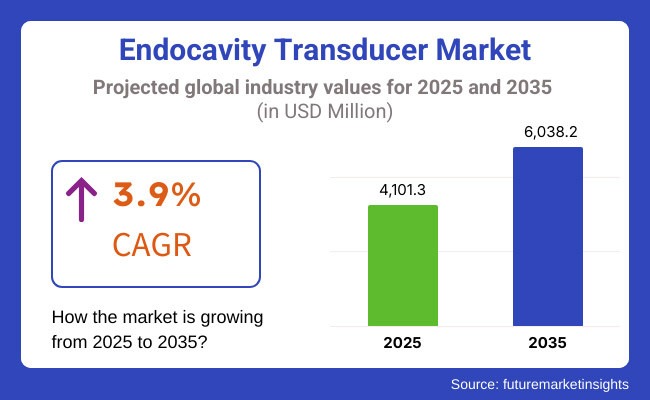
Global Endocavity Transducer Market Poised to Reach USD 6,038.2 Million by 2035, Driven by Rising Demand for Early Disease Diagnosis and Technological Advancements | FMI
 Endocavity Transducer Market
Endocavity Transducer Market
The global endocavity transducer market is on an upward trajectory, with projections estimating it will grow from USD 4,101.3 million in 2025 to USD 6,038.2 million by 2035, reflecting a steady compound annual growth rate (CAGR) of 3.9%. This growth is attributed to the rising incidence of gynecological, urological, and colorectal disorders, along with a mounting emphasis on early diagnosis and minimally invasive imaging techniques.
In 2024, the market generated approximately USD 3,956.6 million in revenue, indicating a healthy baseline for future expansion. As healthcare continues to evolve, the demand for advanced diagnostic tools—particularly those offering precise, real-time imaging—is becoming increasingly critical. Endocavity transducers are emerging as vital instruments in meeting these needs.
Gain Access to Market Trends: Request Your Sample Report! https://www.futuremarketinsights.com/report-sample#5245502d47422d31323536
Market Drivers and Trends
One of the primary growth drivers is the escalating prevalence of prostate and cervical cancers. As these diseases become more common, particularly among aging populations in North America and Europe, the need for enhanced imaging tools grows in parallel. Medical professionals are increasingly opting for non-invasive diagnostic methods that can deliver accuracy without compromising patient comfort.
Endocavity transducers, which are specially designed to image internal organs via body orifices, provide a clear, real-time view that facilitates early-stage detection of diseases. The integration of high-frequency imaging and 3D/4D ultrasound capabilities is enhancing diagnostic precision. In particular, AI-powered ultrasound systems are being adopted rapidly in both hospitals and outpatient settings, streamlining workflows and reducing the margin for error.
As healthcare infrastructure improves globally, developing regions—particularly in Asia-Pacific and Latin America—are witnessing heightened adoption of these technologies. Rising awareness about early diagnosis and disease management is pushing governments and private healthcare providers in these areas to invest more in advanced diagnostic systems.
Additionally, the trend toward portable and wireless ultrasound machines is expanding access to high-quality imaging in rural clinics and other remote locations. This shift is especially crucial for countries with limited access to full-scale hospital facilities.
Evolution of the Endocavity Transducer Market
Initially, ultrasound probes offered limited image resolution, making it difficult to accurately detect complex conditions within the pelvic or abdominal cavity. However, as medical imaging technology has evolved, high-frequency endocavity transducers now provide much greater image clarity and depth.
The development of 3D and 4D imaging has revolutionized the diagnostic process, enabling clinicians to analyze anatomical structures with exceptional precision. These advancements have made endocavity transducers an indispensable part of diagnostic protocols in gynecology, urology, and even gastrointestinal specialties.
Furthermore, as awareness of disease prevention grows, routine health checks now frequently include endocavity imaging, reinforcing their importance across a wider spectrum of medical applications. This transition from specialized use to mainstream medical diagnostics is contributing significantly to market growth.
Heightened Market Interest: Our Complete Report Delivers Extensive Analysis and Trends! https://www.futuremarketinsights.com/reports/endocavity-transducer-market
Key Market Takeaways by Country
- United States
The U.S. market continues to expand due to increasing cases of gynecological and urological disorders, supported by strong adoption of next-generation ultrasound technologies.
CAGR (2025–2035): 3.0%
- Germany
Germany maintains steady market growth driven by its robust healthcare infrastructure and a strong focus on medical research and imaging innovation.
CAGR (2025–2035): 3.5%
- China
China’s endocavity transducer market is witnessing rapid acceleration, supported by a surge in healthcare spending and national efforts promoting early disease detection.
CAGR (2025–2035): 5.3%
- India
With improvements in healthcare access and a growing awareness of disease management, India is poised for strong market expansion.
CAGR (2025–2035): 6.5%
- Brazil
The market in Brazil is benefiting from increased healthcare investments and a growing commitment to proactive diagnosis in men’s and women’s health.
CAGR (2025–2035): 4.7%
Competitive Outlook
The global endocavity transducer market is becoming increasingly competitive as demand surges across diagnostic sectors such as gynecology, urology, and oncology. Key industry players are innovating to meet this demand, focusing on developing transducers that offer higher resolution, ergonomic designs, and seamless integration with AI-based diagnostic software.
Major companies dominating the market include:
- GE Healthcare
- Koninklijke Philips N.V.
- Siemens Healthineers
- Fujifilm Holdings Corporation
- Canon Medical Systems Corporation
- Mindray Medical International Limited
- Toshiba Medical Systems
- Hitachi Medical Systems
- Providian Medical
- Samsung Medison
- Esaote S.p.A.
These companies are leveraging research and development, strategic partnerships, and regional expansions to strengthen their position in this dynamic market.
Key Market Segments
By Product Type:
- Curvilinear
- Phased Array
- Endocavity Transducers
- Linear
By Application:
- Obstetrics/Gynecology
- Urology
By End User:
- Hospitals
- Ambulatory Surgical Centers
- Clinics
- Diagnostic Centers
By Region:
- North America
- Latin America
- Western Europe
- Eastern Europe
- East Asia
- South Asia & Pacific
- Middle East & Africa
Stay Ahead: Subscribe for Weekly Healthcare Market Updates! https://www.futuremarketinsights.com/industry-analysis/diagnostic-devices
Future Outlook
Looking ahead, the global endocavity transducer market holds strong potential for continued growth. With the increasing integration of artificial intelligence and portable solutions, even smaller clinics and rural health centers will have access to powerful diagnostic imaging tools. Meanwhile, evolving patient demographics, such as an aging population and a rising incidence of chronic diseases, will continue to fuel demand for early detection technologies.
As the healthcare industry moves toward more personalized and preventative approaches, endocavity transducers will remain at the forefront of non-invasive, high-precision diagnostics.
Editor Details
-
Company:
- MARKITWIRED
- Website:
